The Department for Education has released provisional figures for the number of trainee teachers recruited for this academic year.
With trainee places for some subjects half or less than half full, recruitment has remained below target in some key EBacc subjects, particularly computing.
Design and technology had the lowest number of trainees overall, with nearly 60 per cent of places unfilled for two years running.
Here are the key findings:
1. Fewer people have started initial teacher training this year
While 27,761 postgraduates chose an ITT route for the academic year 2015 to 2016, there were 532 fewer – at 27,229 – signing up to train as teachers this year.
This means that the number of people taking ITT courses has fallen from more than 35,000 in 2011, to just over 27,000 this year – even though this year and the previous include Teach First applicants for the first time.
The percentage of applicants recruited for secondary school training did rise, from 82 per cent last year to 89 per cent this year – but the government’s target was itself lower that last year, and more of the applicants were recruited.
While the target was lower by 854 places than last year, 530 more applicants were recruited.
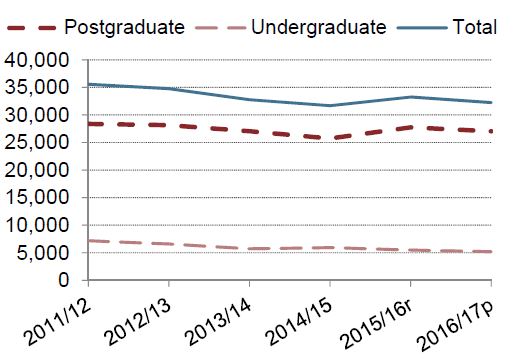
2. Popularity of school-led courses continues to soar
There was a rise in the number of applicants choosing school-led routes to train as teacher, up from 51 per cent last year, to 56 per cent this year. Schools Week has already reported on the rise of school-led routes – the government’s favoured ITT model.
The majority (7,470) were on unpaid School Direct routes, while slightly more than 3,000 were on the salaried School Direct route.
Teach First took 1,375 trainee teachers, while SCITTs took 3,057.
There were around 300 fewer applicants for undergraduate teacher training.
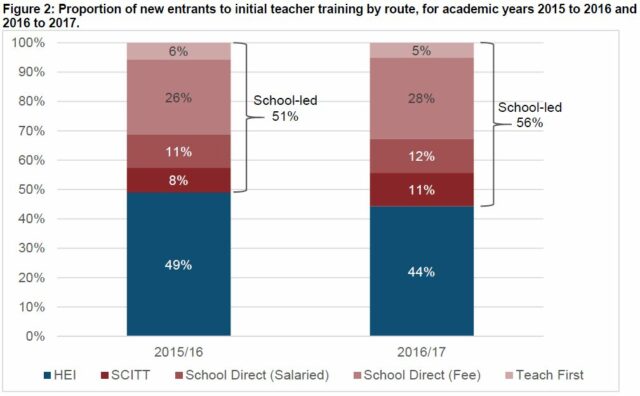
3. Some key Ebacc subjects were under-recruited, again
Recruitment for mathematics against the Teacher Supply Model (TSM) was 26 per cent off target, with only 84 per cent of places filled – although the recruitment target for this year was increased by 521 places compared to last year.
In Physics, only 81 per cent of places were filled. While core subject computing had the lowest level of recruitment out of all EBacc subjects at just 68 per cent; lower than the 70 per cent filled last year.
The government has recently announced funding for a “teacher returner engagement programme” aimed at bringing teachers back into the classroom for mathematics and physics, as well as modern languages.
Several none non-EBacc subjects, including art and design, classics and religious education also saw their targets unmet by about 20 per cent each.
Only 41 per cent of places were filled in design and technology.
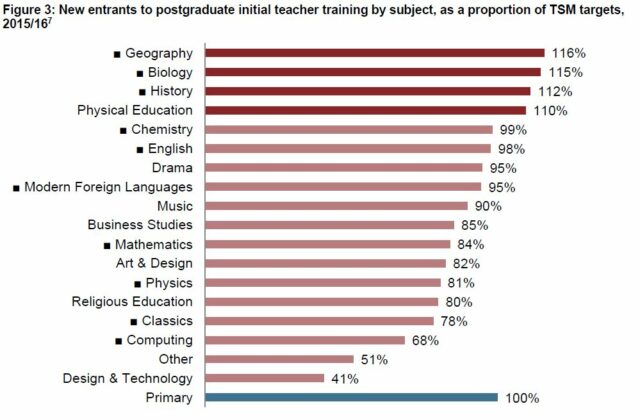
4. Slight drop in ITT applicants with top degrees
Overall, three-quarters of new entrants to ITT programmes had a first class or 2:1 degree this year – a small drop of one percentage point from last year.
The number of applicants with a first class degree was the same as last year, at 18 per cent.
Broken down per provider, just under three-quarters of Teach Firsters this year had a 2:1 degree, and 22 per cent had a first class degree.
Just 16 per cent of applicants on the School Direct salaried route had a first class degree, and 51 per cent had a 2:1 – meaning some 33 per cent held other degree classes, such as 2:2s or thirds.
On the fee-paying, unsalaried School Direct route, more applicants had first class degrees at 18 per cent, and 56 per cent had a 2:1.
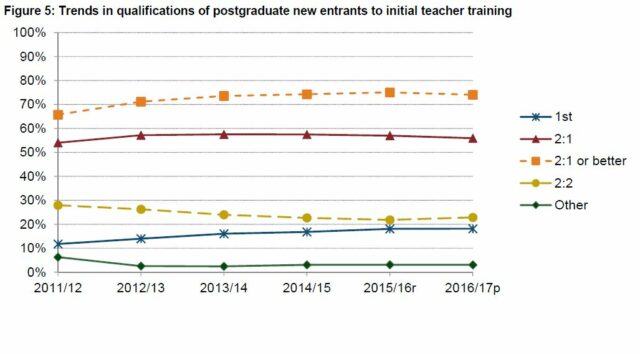
5. Fewer men are training in primary – and younger teachers are less likely to be on a salaried School Direct route
More than half of graduates aged under 25 were took teacher training routes for this year. But just 20 per cent of those on School Direct salaried routes are in this younger age bracket. The other 80 per cent who were salaried were 25 years or older.
At Teach First, on the other hand, nearly three-quarters of all applicants on the course are aged under 25.
Just 15 per cent of all postgraduates on ITT courses were from an ethnic minority background – which is one percentage point more than last year.
Meanwhile, the number of male postgraduates choosing to train in primary education continues to drop. While 23 per cent were accepted onto primary teacher training for 2013 to 2014, that figure is now just one fifth for this year.
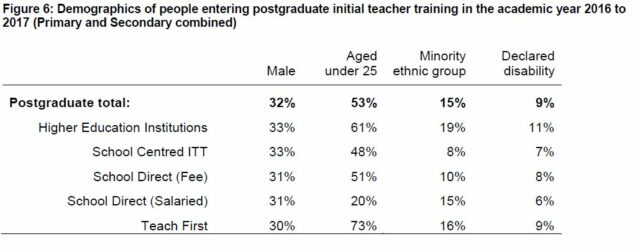



Your thoughts